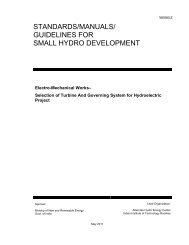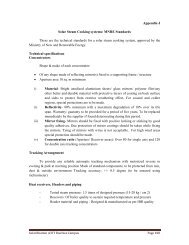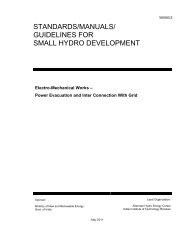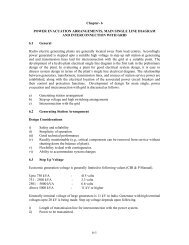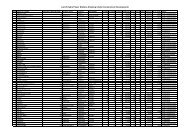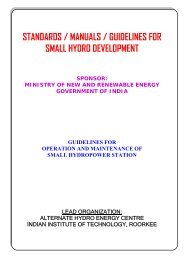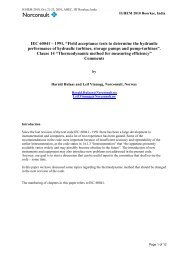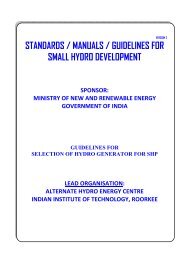standards / manuals / guidelines for small hydro development - AHEC
standards / manuals / guidelines for small hydro development - AHEC
standards / manuals / guidelines for small hydro development - AHEC
You also want an ePaper? Increase the reach of your titles
YUMPU automatically turns print PDFs into web optimized ePapers that Google loves.
elaying. The dead-tank breaker does require additional insulating gas to provide theinsulation between the interrupter and the grounded tank enclosure.Live-tank circuit breakers consist of an interrupter that is mounted on insulators and is atline potential. This approach allows a modular design as interrupters can be connected inseries to operate at higher voltage levels. Operation of the contacts is usually through aninsulated operating rod or rotation of a porcelain insulator assembly by an operator atground level. This design minimizes the quantity of gas used <strong>for</strong> interrupting the arc as noadditional quantity is required <strong>for</strong> insulation of a dead-tank enclosure. The design alsoreadily adapts to the addition of pre-insertion resistors or grading capacitors when theyare required. Seismic capability requires special consideration due to the high center ofgravity of the interrupting chamber assembly.Interrupting times are usually quoted in cycles and are defined as the maximum possibledelay between energizing the trip circuit at rated control voltage and the interruption ofthe main contacts in all poles. This applies to all currents from 25 to 100% of the ratedshort circuit current.Breaker ratings need to be checked <strong>for</strong> some specific application. Applications requiringreclosing operation should be reviewed to be sure that the duty cycle of the circuitbreaker is not being exceeded. Some applications <strong>for</strong> out –of- phase switching or back-tobackswitching of capacitor banks also require review and may require specific dutycircuit breakers to insure proper operation of the circuit breaker during fault interruption.3.1 Vacuum Circuit BreakerVacuum circuit breakers use an interrupter that is a <strong>small</strong>er cylinder enclosing themoving contacts under a high vacuum. When the contacts part, is a <strong>for</strong>med from contacterosion. The arc products are immediately <strong>for</strong>ced to and deposited on a metallic shieldsurrounding the contacts. Without anything to sustain the arc, it is quickly extinguished.Vacuum circuit breaker are widely employed <strong>for</strong> metal-clad switchgear up to 36 kV class.The <strong>small</strong> size of the breaker allows significant savings in space and material comparedto earlier designs employing air magnetic technology. When used in out door circuitbreaker designs, the vacuum cylinder is housed in a metal cabinet or oil filled tank <strong>for</strong>dead tank construction.3.2 Advantages and DisadvantagesAdvantages: Advantages of SF6 breakers over the conventional breakers is given below:i) due to outstanding arc quenching property of SF6, the arcing time is very <strong>small</strong>.This reduces contact erosion.ii) using SF6 gas at low pressure and low velocity; the current chopping can beminimized.4-3



